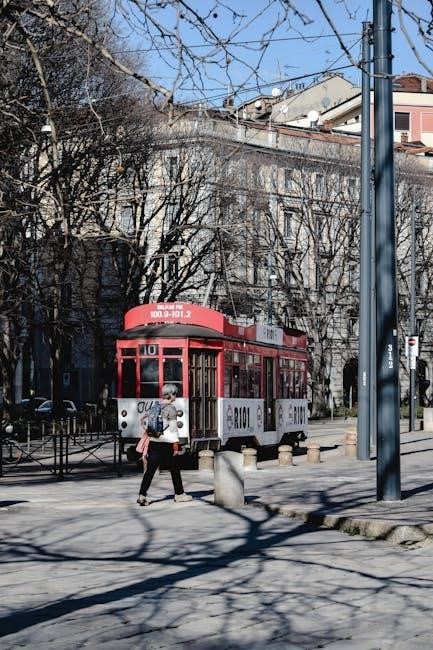Modern Stations of the Cross offer a fresh perspective on Christ’s journey, connecting His Passion to contemporary struggles and using digital media for reflection and prayer.

Significance of the Stations of the Cross in Modern Christianity
The Stations of the Cross hold profound significance in modern Christianity as a powerful devotional practice that connects believers to Christ’s Passion. By reflecting on His journey, Christians deepen their understanding of His sacrifice and its relevance to their lives. This tradition fosters spiritual growth, encouraging followers to embrace their own crosses and find strength in faith. In a world filled with challenges, the Stations offer a timeless reminder of redemption and hope. They also serve as a communal experience, uniting believers in prayer and solidarity. Modern adaptations ensure this ancient practice remains accessible, resonating with contemporary struggles and inspiring personal reflection and transformation.
Overview of the Traditional Stations of the Cross
The Traditional Stations of the Cross consist of 14 devotional reflections, tracing Christ’s journey from condemnation to burial. Each station represents a significant event in His Passion, inviting prayer and meditation. Beginning with “Jesus is Condemned to Death” and ending with “The Body of Jesus is Placed in the Tomb,” these stations have been a cornerstone of Christian devotion for centuries. They blend Scripture, prayer, and reflection, fostering a deep connection to Christ’s sacrifice. The traditional format emphasizes communal participation, often conducted in churches during Lent, and serves as a powerful tool for spiritual growth and penance, encouraging believers to walk in solidarity with Christ.
Why Modern Interpretations Are Necessary
Modern interpretations of the Stations of the Cross are essential to bridge the gap between traditional devotion and contemporary life. They allow believers to connect Christ’s Passion with modern struggles, such as social injustice, poverty, and environmental degradation. By reimagining the Stations in today’s context, they become more relatable and relevant, addressing the challenges faced by modern Christians. These adaptations also incorporate diverse perspectives, making the devotion inclusive and accessible to a broader audience. Additionally, modern interpretations often utilize digital media and innovative formats, enhancing engagement and reflection. This evolution ensures the timeless message of Christ’s sacrifice remains vibrant and meaningful in a rapidly changing world, fostering spiritual growth and solidarity among believers.
The Traditional Format of the Stations of the Cross

The traditional Stations of the Cross include 14 devotional stops, each depicting a pivotal moment in Christ’s Passion, from His condemnation to burial, with prayers and reflections.
Historical Development of the Stations
The Stations of the Cross have their roots in early Christian pilgrimages to Jerusalem, where believers retraced Jesus’ Passion route. Over centuries, this practice evolved, especially after the Crusades, as a way to meditate on Christ’s journey without traveling to the Holy Land. By the 17th century, the Stations were formally established in churches across Europe, with 14 key events from the Gospels. The Vatican’s 1686 standardization further solidified their structure, making them a universal Catholic devotion. This historical foundation laid the groundwork for modern interpretations, blending tradition with contemporary reflections to keep the Stations relevant in today’s world.
Structure and Components of the Traditional Stations
The traditional Stations of the Cross consist of 14 distinct events from Jesus’ Passion, beginning with His condemnation and ending with His burial. Each station is marked by a visual representation, such as a cross or image, accompanied by specific prayers and reflections; The structure is standardized, with each station featuring a meditation on a particular aspect of Christ’s journey. Participants move from one station to the next, engaging in communal or personal prayer. The format emphasizes the physical and spiritual suffering of Christ, inviting believers to reflect on His sacrifice and its significance for humanity. This structured devotion fosters a deep connection to the Passion narrative, encouraging faith and reflection.

Prayer and Reflection in the Traditional Format
Prayer and reflection are central to the traditional Stations of the Cross, fostering a deeper spiritual connection to Christ’s Passion. Each station is accompanied by specific prayers, such as the “Holy God, Holy Mighty” and the “Stabat Mater,” which guide participants in meditation. The format encourages communal or personal prayer, with reflections on the suffering of Christ and its relevance to human experience. Many use prayer booklets or devotional guides to enhance their journey through the stations. The act of moving from one station to another symbolizes a pilgrimage, inviting believers to unite their struggles with Christ’s sacrifice. This practice fosters compassion, gratitude, and a renewed commitment to following Christ’s example of love and self-giving.

Modern Adaptations of the Stations of the Cross
Modern adaptations blend tradition with contemporary perspectives, using digital media, community engagement, and reflections on current issues to make the Stations relevant and accessible today.

Contemporary Reflections on the Passion of Christ
Modern reflections on the Passion of Christ blend traditional devotion with contemporary insights, inviting believers to connect His journey with today’s challenges. By addressing issues like social injustice, personal struggles, and global crises, these reflections highlight the timeless relevance of Christ’s sacrifice. Digital media and innovative formats, such as interactive prayer guides and virtual Stations, make this devotion more accessible and engaging for modern audiences. These adaptations encourage believers to see themselves in Christ’s story, fostering a deeper understanding of His love and redemption. Through such reflections, the Passion becomes a powerful lens for navigating modern life’s complexities while remaining rooted in faith and tradition.
Integrating Modern Struggles into the Stations
Modern Stations of the Cross often incorporate contemporary struggles, such as poverty, inequality, and environmental degradation, to highlight the ongoing relevance of Christ’s Passion. By linking His journey to modern challenges, these reflections encourage believers to see the cross in the suffering of others and in global injustices. Issues like hunger, violence, and exploitation are framed as modern “crosses” that Christ carries alongside those afflicted. This integration fosters empathy and calls believers to action, inspiring them to address these struggles with compassion and hope. Such adaptations ensure the Stations remain a powerful tool for spiritual reflection and social transformation in today’s world.

Use of Digital Media in Modern Stations
Digital media has transformed the Stations of the Cross, making it accessible to a broader audience. PDF booklets, online reflections, and virtual Stations offer convenient ways to engage with the devotion. Websites and apps provide interactive experiences, combining prayers, images, and videos to deepen contemplation. Social media platforms share daily Stations during Lent, fostering community and reflection. Digital art and multimedia presentations enhance the visual and emotional impact of each Station. This modern approach ensures the timeless message of Christ’s Passion remains relevant and engaging in a tech-driven world, while preserving the tradition’s spiritual essence for future generations. Digital media bridges the gap between ancient devotion and contemporary life.

The 14 Stations in a Modern Context
The 14 Stations of the Cross in a modern context explore themes of social justice, personal reflection, and community connection, adapting timeless lessons for today’s challenges.
Station 1: Jesus is Condemned to Death
Station 1 reflects on the injustice and fear that led to Jesus’ condemnation. In a modern context, it invites us to examine societal structures that perpetuate inequality and reject the vulnerable. The cross, symbolizing life’s difficulties, reminds us that Jesus carried the burdens of humanity without complaint. Today, we see parallels in systemic oppression, injustice, and rejection of the marginalized. This station calls us to reflect on our complicity in such systems and to seek justice. By uniting our struggles with Christ’s, we find strength to confront modern challenges. Let us pray for courage to stand against injustice and to walk in solidarity with those who suffer.

Station 2: Jesus Takes Up His Cross
Station 2 emphasizes Jesus’ acceptance of His cross, symbolizing His willingness to embrace suffering for the salvation of humanity. In modern contexts, this station encourages reflection on the burdens we carry, such as inequality, poverty, and personal struggles. Jesus’ calm and courageous demeanor as He took up His cross inspires us to face life’s challenges with resilience. The cross represents not just physical suffering but also the emotional and spiritual weight we bear. By uniting our struggles with Christ’s, we find strength to persevere. This station invites us to pray for the courage to carry our own crosses and to support others in their journeys. Let us ask for grace to embrace our difficulties with faith and hope.
Station 3: Jesus Falls for the First Time
Station 3 captures the moment Jesus falls under the weight of the cross, symbolizing His human vulnerability and the reality of suffering. This station invites reflection on the inevitability of failure and weakness in life. Jesus’ fall reminds us that even in our struggles, God is present and understands our limitations. In modern times, this station resonates with those facing personal hardships, such as mental health challenges, addiction, or loss. It encourages us to embrace our vulnerabilities and seek support, just as Jesus did. By identifying with Christ’s fall, we are reminded that strength often emerges from weakness. Let us pray for the grace to rise again after our own falls, trusting in God’s enduring love and mercy.
Station 4: Jesus Meets His Mother
Station 4 reflects the deeply emotional encounter between Jesus and His mother, Mary, as He carries the cross. This moment highlights the pain of a parent witnessing their child’s suffering. Mary, the Mother of God, embodies unwavering love and faith, even in the face of immense sorrow. In modern times, this station invites reflection on the strength of maternal love and the challenges of family separation or loss. It also reminds us of the universal experience of watching loved ones endure hardship. Let us pray for the grace to emulate Mary’s courage and trust in God’s plan, even amidst pain and uncertainty. May her example inspire us to stand with those who suffer today.
Station 5: The Cross is Laid on Simon of Cyrene
At Station 5, the cross is placed upon Simon of Cyrene, compelling him to assist Jesus in carrying the burden. This moment symbolizes the shared responsibility of bearing life’s hardships and the importance of compassion. In modern times, this station reminds us of the need to support one another in times of struggle, whether personal or societal. It highlights the value of community and the role of individuals in alleviating others’ suffering. Let us reflect on how we can metaphorically “carry the cross” for those around us, offering help and solidarity in a world filled with challenges. May we embrace this act of love and service in our daily lives.
Station 6: A Woman Wipes the Face of Jesus

At Station 6, a compassionate woman wipes the face of Jesus, offering a moment of tenderness amidst His suffering. This act symbolizes unconditional love and care, reminding us of the power of small, selfless gestures. In modern times, this station encourages us to reflect on how we can show kindness to those in need, even in the face of adversity. It challenges us to emulate this woman’s courage and empathy, creating a ripple effect of compassion in our communities. May we strive to be instruments of comfort and love, inspired by her simple yet profound act of mercy.
Station 7: Jesus Falls for the Second Time
Jesus falls for the second time, overwhelmed by the weight of the cross and the brutality He endures. This moment highlights His physical and emotional exhaustion, yet His resolve remains unshaken. In modern times, this station invites us to reflect on our own struggles and resilience. Just as Jesus perseveres, we too can find strength in our faith to carry our burdens. It reminds us that even in repeated failures or hardships, there is hope for redemption and renewal. Let us draw courage from Jesus’ perseverance and commit to rising again, no matter how many times we fall, trusting in God’s grace and love to sustain us.
Station 8: Jesus Meets the Women of Jerusalem
As Jesus falls for the second time, the weight of His cross and the brutality He endures become unbearable. His physical and emotional exhaustion are evident, yet His resolve remains unwavering. In modern times, this station invites us to reflect on our own struggles and resilience. Just as Jesus perseveres, we too can find strength in our faith to carry our burdens. It reminds us that even in repeated failures or hardships, there is hope for redemption and renewal. Let us draw courage from Jesus’ perseverance and commit to rising again, no matter how many times we fall, trusting in God’s grace and love to sustain us.
Station 9: Jesus Falls for the Third Time
Jesus falls for the third time, a moment of profound weakness and vulnerability. His body, battered and exhausted, reflects the cumulative weight of His journey; In modern times, this station reminds us of the universal experience of falling—whether physically, emotionally, or spiritually. It invites us to reflect on our own struggles and the times we have stumbled. Jesus’ perseverance despite His suffering inspires us to rise again, trusting in God’s grace. This station calls us to embrace our humanity and find strength in faith, even when we feel overwhelmed by life’s challenges. Let us pray for the courage to rise and continue our journey, just as Jesus did.
Station 10: Jesus is Stripped of His Garments
At Station 10, Jesus is stripped of His garments, exposing His vulnerability and humiliation. This moment highlights the cruelty of the crucifixion process, as His dignity is stripped away. In modern contexts, this station resonates with themes of exploitation, injustice, and the dehumanization of individuals. It invites us to reflect on how society often strips people of their dignity—through poverty, discrimination, or marginalization. Jesus’ endurance in the face of such suffering calls us to stand in solidarity with those who are oppressed. Let us pray for the grace to recognize the inherent dignity of every person and to advocate for justice in a world that often seeks to strip it away.
Station 11: Jesus is Nailed to the Cross
At Station 11, Jesus is nailed to the cross, symbolizing the ultimate sacrifice for humanity’s sins. This act of crucifixion represents the depth of His love and commitment to redemption. In modern times, this station can be seen as a powerful metaphor for selfless service and the willingness to endure pain for the greater good. It challenges us to reflect on how we can surrender our own wills to God’s plan, even in the face of suffering. Let us pray for the strength to embrace our own crosses and to follow Christ’s example of unwavering love and sacrifice. May His sacrifice inspire us to live with compassion and humility.
Station 12: Jesus Dies on the Cross
Station 12 marks the culmination of Christ’s Passion, as He breathes His last on the cross. His death signifies the ultimate sacrifice for humanity’s redemption, embodying divine love and mercy; In modern times, this station invites reflection on the cost of forgiveness and the transformative power of selfless love. It challenges us to consider how we might surrender our own lives to God’s will, even in the face of suffering. Jesus’s final words, “It is finished,” remind us of the completeness of His sacrifice. Let us pray for the grace to embrace the depth of His love and to live in the hope of eternal life. May His death inspire us to love without bounds.
Station 13: The Body of Jesus is Taken Down from the Cross
Station 13 reflects on the profound moment when Jesus’s lifeless body is removed from the cross, entrusted to the care of Joseph of Arimathea and Nicodemus. This scene embodies the dignity and tenderness with which Jesus’s body is treated, even in death. In modern contexts, this station invites us to contemplate the value of compassion and the importance of honoring the deceased. It also serves as a reminder of the community’s role in caring for one another, even in the face of loss. As we reflect on this station, we are called to find comfort in the knowledge that Jesus’s death was not the end but a transition to new life. May we find solace in His sacrifice and hope in the promise of resurrection.
Station 14: The Body of Jesus is Placed in the Tomb
Station 14 marks the final act of Jesus’s Passion, where His body is gently laid in the tomb by Joseph of Arimathea and Nicodemus. This moment signifies the stillness and surrender of death, yet it also holds the promise of resurrection. In modern interpretations, the tomb represents the ultimate letting go, inviting us to reflect on our own struggles with endings and new beginnings. The placement of Jesus’s body in the tomb reminds us of the dignity of human life, even in death, and the hope that transcends it. As we pray this station, we are called to trust in God’s plan and find peace in the darkness, knowing that life will emerge anew.